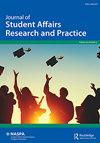双语对认知储备的影响及其对认知衰退的保护作用
IF 0.8
Q3 EDUCATION & EDUCATIONAL RESEARCH
Journal of Student Affairs Research and Practice
Pub Date : 2023-05-31
DOI:10.47611/jsrhs.v12i2.4229
引用次数: 0
摘要
认知能力下降存在于一个范围内,从轻度认知障碍到痴呆。这两种诊断包含了一组植根于认知功能逐渐衰退的症状,损害了记忆、决策、语言使用和运动等方面。这篇综述的中心是认知储备的前提,认知储备是一种无形的衡量大脑的弹性和补偿损伤的能力,以及它与以后生活中认知功能的保存的关系。双语能力是提高认知储备的众多因素之一;然而,这一术语未能反映每个人固有的独特语言特征,包括第二语言是在童年时期还是在以后的生活中习得的。因此,“获得性”和“终身”双语的区别是明确的。通过对任务基础和神经影像学数据的分析,本文阐述了两种形式的双语对认知储备的影响,并揭示了当两种语言在不同的环境中以积极的方式经常使用时,所产生的神经保护优势最为突出。这些实践在习得性和终身双语者中都有不同程度的观察,本文将对其进行背景化和详细探讨。本文章由计算机程序翻译,如有差异,请以英文原文为准。
The Impact of Bilingualism on Cognitive Reserve as a Protectant Against Cognitive Decline
Cognitive decline exists on a spectrum, ranging from mild cognitive impairment to dementia. These two diagnoses encompass a group of symptoms rooted in the progressive decline of cognitive function, impairing aspects like memory, decision-making, language use, and locomotion. This review centers upon the premise of cognitive reserve, an intangible measure of the brain’s resilience and capacity to compensate for damage, and its relationship with the preservation of cognitive function later in life. Bilingualism constitutes one of many contributing factors to a higher cognitive reserve; however, this term fails to reflect the unique linguistic profile intrinsic to every individual—including whether a second language was acquired during childhood or later in life. Therefore, a distinction between “acquired” and “lifelong” bilingualism is made. Through the analysis of task-based and neuroimaging data, this review article elucidates the impact both forms of bilingualism have on cognitive reserve as a protectant against cognitive decline, revealing that resultant neuroprotective advantage is most salient when both languages are used regularly, in diverse environments, and in an active manner. These practices are observed in both acquired and lifelong bilinguals to varying degrees, which are contextualized and explored in detail within the review.
求助全文
通过发布文献求助,成功后即可免费获取论文全文。
去求助
来源期刊

Journal of Student Affairs Research and Practice
EDUCATION & EDUCATIONAL RESEARCH-
CiteScore
2.40
自引率
9.10%
发文量
50
期刊介绍:
The vision of the Journal of Student Affairs Research and Practice (JSARP) is to publish the most rigorous, relevant, and well-respected research and practice making a difference in student affairs practice. JSARP especially encourages manuscripts that are unconventional in nature and that engage in methodological and epistemological extensions that transcend the boundaries of traditional research inquiries.
 求助内容:
求助内容: 应助结果提醒方式:
应助结果提醒方式:


